NCERT Exemplar: Surface Chemistry (Old NCERT) | Chemistry for JEE Main & Advanced PDF Download
| Table of contents |

|
| Multiple Choice Questions |

|
| Short Answer Type Questions |

|
| Matching Type |

|
| Assertion and Reason Type |

|
Multiple Choice Questions
Q.1. Which of the following process does not occur at the interface of phases?
(i) Crystallisation
(ii) Heterogeneous catalysis
(iii) Homogeneous catalysis
(iv) Corrosion
Ans. (iii)
Solution.
Homogeneous catalysis does not occur at the interface of phases as in case of homogeneous catalysis reactant and catalyst have same phase and their distribution is uniform throughout.
Q.2. At the equilibrium position in the process of adsorption ___________.
(i) ∆H > 0
(ii) ∆H = T∆S
(iii) ∆H > T∆S
(iv) ∆H < T∆S
Ans. (ii)
Solution.
∆H = TDS
As we know that, al equilibrium ∆G = 0
∆H - T∆S = 0
∆H = T∆S
Hence, at equilibrium enthalpy change is equal to product of temperature and entropy change.
Q.3. Which of the following interface cannot be obtained?
(i) Liquid-liquid
(ii) Solid-liquid
(iii) Liquid-gas
(iv) Gas-gas
Ans. (iv)
Solution.
Gas-gas Interface cannot be obtained as they are completely miscible in nature. e.g., air is a mixture of various gases such as O2, N2, CO2 etc.
Q.4. The term ‘sorption’ stands for ____________.
(i) Absorption
(ii) Adsorption
(iii) Both absorption and adsorption
(iv) Desorption
Ans. (iii)
Solution.
- Sorption stands for both absorption and adsorption.
- We can understand this by using following figures:
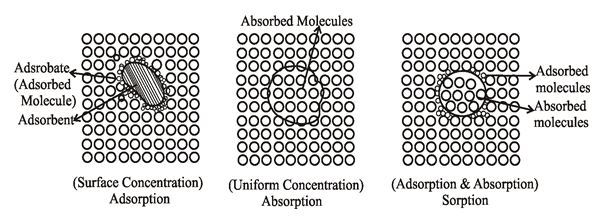 Q.5. Extent of physisorption of a gas increases with ___________.
Q.5. Extent of physisorption of a gas increases with ___________.
(i) Increase in temperature.
(ii) Decrease in temperature.
(iii) Decrease in surface area of the adsorbent.
(iv) Decrease in strength of van der Waals forces.
Ans. (ii)
Solution.
Extent of physisorption of a gas increases with a decrease in temperature. Because in physisorption particles are held to the surface by weak van der Waals’ force of attraction hence on increasing temperature they get desorbed easily.
Q.6. Extent of adsorption of adsorbate from solution phase increases with ________.
(i) Increase in amount of adsorbate in solution.
(ii) Decrease in surface area of adsorbent.
(iii) Increase in temperature of solution.
(iv) Decrease in amount of adsorbate in solution.
Ans. (i)
Solution.
Extent of adsorption of adsorbate from solution phase increases with increase in amount of adsorbate in solution. As amount of adsorbate in the solution increases, interaction of adsorbate with adsorbent also increases which leads to increase in extent of adsorption.
Q.7. Which one of the following is not applicable to the phenomenon of adsorption?
(i) ∆H < 0
(ii) ∆G < 0
(iii) ∆S < 0
(iv) ∆H > 0
Ans. (i)
Solution.
For phenomenon of adsorption ∆H < 0, i.e., enthalpy change during phenomenon of adsorption is negative because during adsorption, there is always a decrease in residual forces of the surface which lead to decrease in surface energy which appears as heat. So, adsorption is an exothermic process and ∆H < 0.
Q.8. Which of the following is not a favourable condition for physical adsorption?
(i) High pressure
(ii) Negative ∆H
(iii) Higher critical temperature of adsorbate
(iv) High temperature
Ans. (iv)
Solution.
Physisorption is a process in which adsorbate get adsorbed on the adsorbent surface by weak van der Waals’ force of attraction. On increasing temperature the interaction between adsorbate and adsorbent becomes weak and adsorbate particles get desorbed.
Q.9. Physical adsorption of a gaseous species may change to chemical adsorption with ______________.
(i) Decrease in temperature
(ii) Increase in temperature
(iii) Decrease in surface area of adsorbent
(iv) Decrease in surface area of adsorbent
Ans. (ii)
Solution.
On increasing temperature, physisorption changes to chemisorption. As temperature increases, energy of activation of adsorbate particles increases which leads to formation of chemical bond between adsorbate and adsorbent. Hence, physisorption transform into chemisorption.
Q.10. In physisorption adsorbent does not show specificity for any particular gas because ______________.
(i) Involved van der Waals forces are universal.
(ii) Gases involved behave like ideal gases.
(iii) Enthalpy of adsorption is low.
(iv) It is a reversible process.
Ans. (i)
Solution.
In physisorption adsorbent does not show specificity for any particular gas because involved van der Waals forces are universal. It means extent of van der Waals’ interaction between adsorbate and adsorbent is constant for all gases.
Q.11. Which of the following is an example of absorption?
(i) Water on silica gel
(ii) Water on calcium chloride
(iii) Hydrogen on finely divided nickel
(iv) Oxygen on metal surface
Ans. (ii)
Solution.
Absorption means penetration of adsorbate molecules into the bulk of the adsorbent e.g., water on calcium chloride. When water is spread over calcium chloride, it gets penetrated into bulk of the calcium chloride.
Q.12. On the basis of data given below predict which of the following gases shows
least adsorption on a definite amount of charcoal?
(i) CO2
(ii) SO2
(iii) CH4
(iv) H2
Ans. (iv)
Solution.
Lesser the value of critical temperature of gases lesser will be the extent of adsorption. Here H2 has lowest value of critical temperature, i.e., 33. Hence, hydrogen gas shows least adsorption on a definite amount of charcoal.
Q.13. In which of the following reactions heterogenous catalysis is involved?
(a) 2SO2 (g) + O2(g) → 2SO3(g)
(b) 2SO2 (g) → 2SO3(g)
(c) N2 (g) + 3H2 (g) → 2NH3 (g)
(d) CH3COOCH3 (l) + H2O (l) → CH3COOH (aq) + CH3OH (aq)
(i) (b), (c)
(ii) (b), (c), (d)
(iii) (a), (b), (c)
(iv) (d)
Ans. (iii)
Solution.
Reaction in which catalyst is in different phase than the reactants and products, is known as heterogeneous catalysis.
(i) 2SO2 (g) + O2 (g) → 2SO3(g)
Here, reactants (SO2 and O2), product (SO3) and catalyst (NO) are all in gaseous phase.
Therefore, here heterogeneous catalysis is not involved
(ii) 2SO2 (g) → 2SO3 (g)
Here, reactant SO2 and product SO3 are in gaseous phase while platinum is in solid phase. So, this reaction represents a heterogeneous catalysis.
(iii) N2 (g) + 3H2 (g) → 2NH3 (g)
Similarly, here N2 and H2 reactants are in gaseous phase while NH3 is in solid phase. So, this reaction also represents a heterogeneous catalysis.
Q.14. At high concentration of soap in water, soap behaves as _______________.
(i) Molecular colloid
(ii) Associated colloid
(iii) Macromolecular colloid
(iv) Lyophilic colloid
Ans. (ii)
Solution.
Associated colloid At high concentration of soap in water, soap particles present in the solution get associated around and lead to formation of associated colloid.
Q.15. Which of the following will show Tyndall effect?
(i) Aqueous solution of soap below critical micelle concentration.
(ii) Aqueous solution of soap above critical micelle concentration.
(iii) Aqueous solution of sodium chloride.
(iv) Aqueous solution of sugar.
Ans. (ii)
Solution.
Aqueous solution of soap above critical micelle concentration leads to formation of colloidal solution. Tyndall effect is a characteristic of colloidal solution in which colloidal particles show a coloured appearance when sunlight is passed through it and seen from the perpendicular side.
Q.16. Method by which lyophobic sol can be protected.
(i) By addition of oppositely charged sol.
(ii) By addition of an electrolyte.
(iii) By addition of lyophilic sol.
(iv) By boiling.
Ans. (iii)
Solution.
Lyophobic sol can be protected by addition of lyophilic sol. As lyophobic sols are readily precipitated on addition of small amount of electrolytes or shaking, or heating hence they are made stable by adding lyophillic sol which stabilises the lyophobic sols.
Q.17. Freshly prepared precipitate sometimes gets converted to colloidal solution by ___________.
(i) Coagulation
(ii) Electrolysis
(iii) Diffusion
(iv) Peptisation
Ans. (iv)
Solution.
Freshly prepared precipitate sometimes gets converted to colloidal solution by peptisation. Peptisation is a process in which by addition of a suitable peptising agent precipitate gets converted into colloidal solution.
Q.18. Which of the following electrolytes will have maximum coagulating value for AgI/Ag+ sol?
(i) Na2S
(ii) Na3PO4
(iii) Na2SO4
(iv) NaCl
Ans. (ii)
Solution.
According to Hardy-Schulze law, greater the charge on anion greater will be its coagulating power.
Here, PO3-4 have highest charge. Hence, PO3-4 have highest coagulating power.
Q.19. A colloidal system having a solid substance as a dispersed phase and a liquid as a dispersion medium is classified as ____________.
(i) Solid sol
(ii) Gel
(iii) Emulsion
(iv) Sol
Ans. (iv)
Solution.
Sol is a colloidal system in which solid substance is a dispersed phase and a liquid is a dispersion medium, e.g., paint, cell fluids etc.
In paints solid colouring particles are dissolved in liquid dispersion medium.
Q.20. The values of colligative properties of colloidal solution are of small order in comparison to those shown by true solutions of same concentration because of colloidal particles __________________.
(i) Exhibit enormous surface area.
(ii) Remain suspended in the dispersion medium.
(iii) Form lyophilic colloids.
(iv) Are comparatively less in number.
Ans. (iv)
Solution.
The values of colligative properties of colloidal solution are of small order in comparison to those of true solution of same concentration because of colloidal particles are comparatively less in number.
This is due to slight large size of colloidal particles in comparison to particles present in true solution. Size of colloidal particles is in between 1 nm to 1000 nm.
Q.21. Arrange the following diagrams in correct sequence of steps involved in the mechanism of catalysis, in accordance with modern adsorption theory.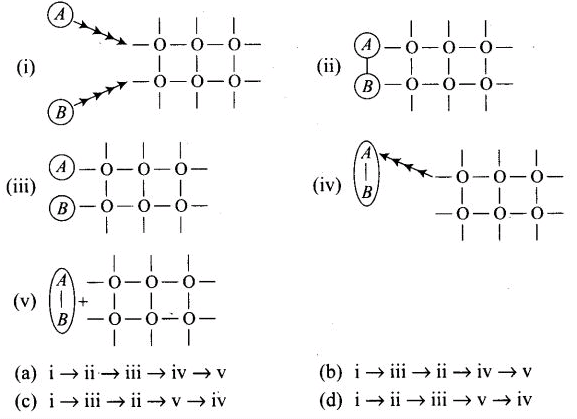
Ans. (b)
Solution.
(b) Correct sequence is i —» iii -» ii —»iv -> v
Each transformation denotes a meaningful process as follows:
i → adsorption of A and B on surface.
iii → ii interaction between A and B to form intermediate.
ii → iv starting desorption of A-B.
iv → v complete desorption.
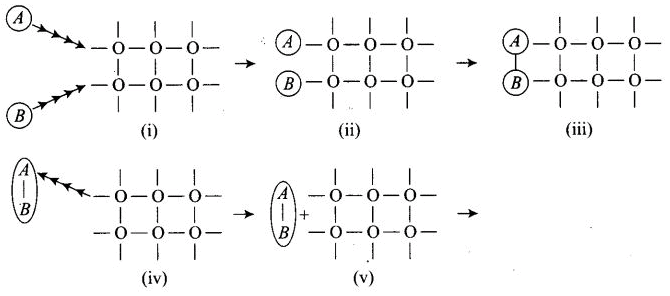
Q.22. Which of the following process is responsible for the formation of delta at a place where rivers meet the sea?
(i) Emulsification
(ii) Colloid formation
(iii) Coagulation
(iv) Peptisation
Ans. (iii)
Solution.
River water is a colloidal solution of clay and sea. Water contains various electrolytes. When river water comes in contact with sea water, then the electrolytes present in sea water coagulate the suspended colloidal particles which ultimately settle down at the point of contact.
Q.23. Which of the following curves is in accordance with Freundlich adsorption isotherm?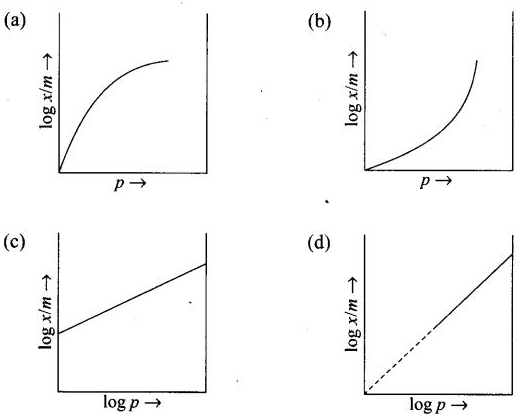
Ans. (c)
Solution.
According to the Freundlich adsorption isotherm
Taking log on both side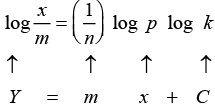

On comparing it with equation of straight line and drawing the graph log x/m versus log ρ, we get a siraight line with intercept log k and slope of the straight line gives the value of 1/n
Q.24. Which of the following process is not responsible for the presence of electric charge on the sol particles?
(i) Electron capture by sol particles.
(ii) Adsorption of ionic species from solution.
(iii) Formation of Helmholtz electrical double layer.
(iv) Absorption of ionic species from solution.
Ans. (iv)
Solution. Absorption of ionic species from solution is not responsible for the presence of electric charge on the sol particles.
Charge on the sol particles is due to:
- Electrons capture by sol particles during electro dispersion of metal.
- Preferential adsorption of ionic species from solution.
- Formation of Helmholtz electrical double layer.
Q.25. Which of the following phenomenon is applicable to the process shown in the figure?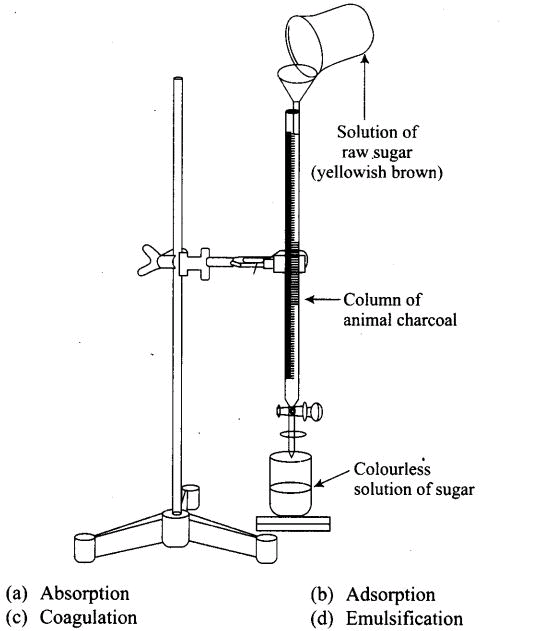
Ans. (b)
Solution.
- Above figure represent adsorption of yellowish brown colour of raw sugar by animal charcoal.
- Here, aqueous solution of raw sugar is filtered by using animal charcoal. Yellowish brown colour of raw sugar is adsorbed and filterate is colourless which gives white colour on cystallisation. Hence, this phenomenon is adsorption.
Multiple Choice Questions
Note: In the following questions two or more options may be correct.
Q.26. Which of the following options are correct?
(i) Micelle formation by soap in aqueous solution is possible at all temperatures.
(ii) Micelle formation by soap in aqueous solution occurs above a particular concentration.
(iii) On dilution of soap solution micelles may revert to individual ions.
(iv) Soap solution behaves as a normal strong electrolyte at all concentrations.
Ans. (ii, iii)
Solution.
- Micelle formation: Some substances at low concentration behave as a normal electrolyte but at higher concentration exhibit colloidal behaviour due to formation of micelles.
- CMC (Critical Micelle Concentration) the concentration above which it behaves as a micelle known as critical micelle concentration (CMC). e.g., soap solution in aqueous solution above particular concentration (called CMC = 10-4 - 103 mol L-1) forms soap micelles.
- On dilution soap solution behaves as a normal electrolyte and after adding excess of water intermolecular force of attraction between the soap particles decreases and soap solution micelles may revert to individual ions.
Q.27. Which of the following statements are correct about solid catalyst?
(i) Same reactants may give different product by using different catalysts.
(ii) Catalyst does not change ∆H of reaction.
(iii) Catalyst is required in large quantities to catalyse reactions.
(iv) Catalytic activity of a solid catalyst does not depend upon the strength of chemisorption.
Ans. (i, ii)
Solution.
(i) Same reactants may give different products by using different catalysts as different catalysts have different specific functions to mould the reaction towards specific product. e.g., starting with H2 and CO, and using different catalysts, we get different products.
(i) CO (g) + 3H2 → CH4 (g) + H2O (g)
(ii) CO (g) +2H2 (g) → CH3OH (g)
(iii) CO (g) + H2 (g) → HCHO (g)
(ii) Catalyst does not change ∆H of reaction as ∆H of reaction is difference between enthalpy of reactants and products. So, it does not change during catalysed reaction.
Q.28. Freundlich adsorption isotherm is given by the expression which of the following conclusions can be drawn from this expression.
which of the following conclusions can be drawn from this expression.
(i) When 1/n = 0, the adsorption is independent of pressure.
(ii) When 1/n = 0, the adsorption is directly proportional to pressure.
(iii) When n = 0, x/m versus p graph is a line parallel to x-axis.
(iv) When n = 0, plot of x/m vs p is a curve.
Ans. (i, iii)
Solution.
According to Freundlich adsorption isotherm
(i) At 1/n = 0 this equation becomes
Extent of adsorption is independent of pressure.
(c) At x = 0,
Hence, x/m vs p graph can be plotted as m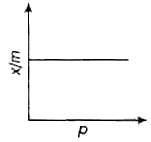
Q.29. H2 gas is adsorbed on activated charcoal to a very little extent in comparison to easily liquefiable gases due to ____________.
(i) Very strong van der Waal’s interaction.
(ii) Very weak van der Waals forces.
(iii) Very low critical temperature.
(iv) Very high critical temperature.
Ans. (ii, iii)
Solution.
H2 gas is adsorbed on activated charcoal to a very little extent in comparison to easily liquefiable gases due to
(i) very low van der Waals’ forces and
(ii) very low critical temperature equal to 33 K.
Q.30. Which of the following statements are correct?
(i) Mixing two oppositely charged sols neutralises their charges and stabilises the colloid.
(ii) Presence of equal and similar charges on colloidal particles provides stability to the colloids.
(iii) Any amount of dispersed liquid can be added to emulsion without destabilising it.
(iv) Brownian movement stabilises sols.
Ans. (ii, iv)
Solution.
Presence of equal and similar charges on colloidal particles provides stability to colloids as repulsive forces between charge particles having same charge prevent them from colliding when they come closer to each other.
Q.31. An emulsion cannot be broken by __________ and ___________.
(i) Heating
(ii) Adding more amount of dispersion medium
(iii) Freezing
(iv) Adding emulsifying agent
Ans. (ii, iv)
Solution.
Emulsions are liquid-liquid colloidal system. They can’t be broken by adding more amount of dispersion medium and adding emulsifying agent as on adding more amount of dispersion medium they become dilute and on adding emulsifying agent they get stabilises.
Q.32. Which of the following substances will precipitate the negatively charged emulsions?
(i) KCl
(ii) Glucose
(iii) Urea
(iv) NaCl
Ans. (i, iv)
Solution.
The droplets present in emulsion have negative charge. It can be precipitated by adding electrolyte such as KCl, NaCl etc. Since, glucose and urea do not produce ions on dissolving in water. Hence, they are non-electrolyte and do not precipitate the negatively charged emulsion.
Q.33. Which of the following colloids cannot be coagulated easily?
(i) Lyophobic colloids.
(ii) Irreversible colloids.
(iii) Reversible colloids.
(iv) Lyophilic colloids.
Ans. (iii, iv)
Solution.
Lyophilic colloids (liquid loving colloids) which are also known as reversible colloids can’t be coagulated easily. The stability of these colloids is due to
(i) charge on colloidal particles and
(ii) solvation of colloidal particles.
Q.34. What happens when a lyophilic sol is added to a lyophobic sol?
(i) Lyophobic sol is protected.
(ii) Lyophilic sol is protected.
(iii) Film of lyophilic sol is formed over lyophobic sol.
(iv) Film of lyophobic sol is formed over lyophilic sol.
Ans. (i, iii)
Solution.
Lyophobic sol is unstable in nature. When lyophilic sol is added to lyophobic sol then lyophobic sol is protected because a film of lyophilic sol is formed over lyophobic sol.
Hence, (i) and (iii) are correct.
Q.35. Which phenomenon occurs when an electric field is applied to a colloidal solution and electrophoresis is prevented?
(i) Reverse osmosis takes place.
(ii) Electroosmosis takes place.
(iii) Dispersion medium begins to move.
(iv) Dispersion medium becomes stationary.
Ans. (ii, iii)
Solution.
The movement of colloidal particles under an applied electric potential is called electrophoresis. When this movement of particles is prevented by some suitable means, it is observed that the dispersion medium begins to move in an electric field. This phenomenon is termed as electroosmosis.
Q.36. In a reaction, catalyst changes ____________.
(i) Physically
(ii) Qualitatively
(iii) Chemically
(iv) Quantitatively
Ans. (i, ii)
Solution.
Substances; which accelerate the rate of a chemical reaction and themselves remain chemically and quantitatively unchanged after the reaction, are known as catalysts. They can undergo physical change.
Q.37. Which of the following phenomenon occurs when a chalk stick is dipped in ink?
(i) Adsorption of coloured substance
(ii) Adsorption of solvent
(iii) Absorption and adsorption both of solvent
(iv) Absoprtion of solvent
Ans. (i, iv)
Solution.
When a chalk stick is dipped in ink absorption as well as absorption both occurs. Adsorption of coloured substance and absorption of solvent takes place.
Short Answer Type Questions
Q.38. Why is it important to have clean surface in surface studies?
Ans. It facilitates the adsorption of desired species. If surface is covered by the gases of air then it will not be available for adsorption of desired gases. So, it is very important to have clean surface in surface studies i.e., study of surface chemistry.
Q.39. Why is chemisorption referred to as activated adsorption?
Ans. Chemisorptions referred to as activated adsorption as it involves chemical bond formation between reactant and adsorbent molecules. Formation of chemical bond requires high activation energy, So, it is activated on increasing temperature.
Q.40. What type of solutions are formed on dissolving different concentrations of soap in water?
Ans. At lower concentration, soap behaves as a normal solution of elecrolyie in water However, after a certain concentration, called critical micelle concentraiion, colloidal solution is formed due to aggregation of colloidal particles. CMC for soap solution is 1 Cr-4 to 10-3 mol L-1.
Q.41. What happens when gelatin is mixed with gold sol?
Ans. Gold sol is a solvent repelling sol i.e., a lyophobic sol and unstable in nature. Addition of gelatin stabilises the gold sol because gelatin forms lyophilic sol and set as a protective colloid.
Q.42. How does it become possible to cause artificial rain by spraying silver iodide on the clouds?
Ans. As we know artificial rainfall occurs when oppositely charged clouds meets. Since, clouds are colloidal in nature and carry charge. Spray of silver iodide, an electrolyte from aeroplane results in coagulation of colloidal water particles leading to rain. Sometimes electrified sand is also used for this purpose.
Q.43. Gelatin which is a peptide is added in icecreams. What can be its role?
Ans. Emulsifying agent is added to emulsion to stabilise the emulsion. Emulsifying agent form a layer between suspended particles and the medium and hence stabilises the emulsion. Ice cream (emulsion) is stabilised by emulsifying agent ike gelatin.
Q.44. What is collodion?
Ans. It is a 4% solution of nitrocellulose in a mixture of alcohol and ether.
Q.45. Why do we add alum to purify water?
Ans. We add alum to purify water as alum coagulates trie coiicidal Impurities present in water, so that these impurities get settle down and remove by decantation or tiltraron. Thus water gets purified by adding alum to water.
Q.46. What happens when electric field is applied to colloidal solution?
Ans.
- When electric potential is applied to colloidal solution, the colloidal particles move towards one or other electrode. Positively charged particles move towards the cathode while negatively charged particles move towards the anode.
- The movement of colloidal particles under an applied electric potential is called electrophoresis. When electrophoresis is prevented by some is ears, then the dispersion medium begins to move in an electric field This phenomenon is termed as electroosmosis.
Q.47. What causes Brownian motion in colloidal dispersion?
Ans. Brownian movement may be defined as continuous zig-zag movement of colloidal particles in a colloidal sol. A state of continuous zig-zag motion of colloidal particles appears to be in view due to unbalanced bombardment of the particles of dispersed phase by molecules of dispersion medium. This Brownian movement stabilises the sol.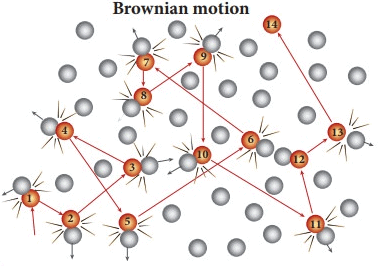
Q.48. A colloid is formed by adding FeCl3 in excess of hot water. What will happen if excess sodium chloride is added to this colloid?
Ans. Positively charged ions coagulate the negatively charged sol and negatively charged ion coagulate the positively charged sol Positively charged sol of hydrated ferric oxide s formed when FeCI3 is added in excess of hot water. On adding excess of NaCl to this sol, negatively charged Cl- ions coagulate the positively charged sol of hydrated ferric oxide.
Q.49. How do emulsifying agents stabilise the emulsion?
Ans. Emulsifying agents stabilise the emulsion by forming an interfacial layer between suspended particles and the dispersion medium, e.g., gelatin is added to ice cream to stabilise it.
Q.50. Why are some medicines more effective in the colloidal form?
Ans. Some medicines are more effective in colloidal form because they have large surface area and are easily assimilated in the body.
Q.51. Why does leather get hardened after tanning?
Ans. Animal hide is colloidal in nature and has positively charged particles. When it is soaked in tanin (negatively charged), a colloid, it results in mutual coagulation and gets harden. Thus, leather get hardened after tanning.
Q.52. How does the precipitation of colloidal smoke take place in Cottrell precipitator?
Ans. In Cottrell precipitator, smoke particles (charged) are passed through a chamber containing plates with charge opposite to the smoke particles. Smoke particles lose their charge on the plates and get precipitated.
Q.53. How will you distinguish between dispersed phase and dispersion medium in an emulsion?
Ans. To distinguish between dispersed phase and dispersion medium we increase the concentration of any one dispersion medium or dispersed phase then notice the change.
When dispersion medium is added to an emulsion, it gets diluted to any extent. But on adding dispersed phase it forms a separate layer, if added in excess.
Q.54. On the basis of Hardy-Schulze rule explain why the coagulating power of phosphate is higher than chloride.
Ans.
- Minimum quantity of an electrolyte required to cause precipitation of a sol is called its coagulating value. Greater the charge on flocculating ion and smaller is the amount of electrolyte required for precipitation, higher is the coagulating power of coagulating ion (Hardy-Schuize Law).
- Phosphate ion bear - 3 charge while chloride ion carries only -1 charge and due to high charge phosphate ion has high coagulating power than that of chloride ion.
Q.55. Why does bleeding stop by rubbing moist alum?
Ans. Blood is a colloidal sol. When we rub the injured part with moist alum then coagulation of blood takes place. Hence, main reason is coagulation, which stops the bleeding.
Q.56. Why is Fe(OH)3 colloid positively charged, when prepared by adding FeCl3 to hot water?
Ans. Charge on sol is decided by adsorption of ions present in medium. Adsorption of positively charged Fe3+ ions takes place by the sol of hydrated ferric oxide. Thus, Fe(OH)3 colloid has positive charge when prepared by adding Fe(OH)3 to hot water.
Q.57. Why do physisorption and chemisorption behave differently with rise in temperature?
Ans.
- Behaviour of physisorption and chemisorption on increase in temperature can be explained on the basis of nature of forces present to bind their particles.
- Physisorption involves weak van der Waals’ forces which weaken with increase in temperature.
- Chemisorption involves formation of chemical bond which requires activation energy. Hence, it is favoured by rise in temperature.
Q.58. What happens when dialysis is prolonged?
Ans. Due to excessive dialysis, traces of electrolyte which stabilise the colloids is removed completely, making the colloid unstable. As a result, coagulation takes place.
Q.59. Why does the white precipitate of silver halide become coloured in the presence of dye eosin.
Ans. White coloured precipitate of silver halide becomes coloured in the presence of dye eosin because dye eosin (coloured) gets adsorbed on the surface of silver halide precipitate.
Q.60. What is the role of activated charcoal in gas mask used in coal mines?
Ans. Role of activated charcoal in gas mask can be explained on the basis of adsorption. Activated charcoal adsorbs various poisonous gases on its surface present in coal mines.
Q.61. How does a delta form at the meeting place of sea and river water?
Ans. Formation of delta at the meeting place of sea and river water is due to coagulation. River water (colloid of sea water + clay) has many dissolved electrolytes. The place where river meets sea is the site for coagulation. Deposition of coagulated clay results in delta formation.
Q.62. Give an example where physisorption changes to chemisorption with rise in temperature. Explain the reason for change.
Ans. Adsorption of H2 on finely divided nickel (physisorption) involves weak van der Waals’ forces. When temperature is increased, hydrogen molecules dissociate into hydrogen atoms, form chemical bonds with the rnetal atoms at the surface (chemisorption).
Q.63. Why is desorption important for a substance to act as good catalyst?
Ans. Desorption is important for a substance to act as a good catalyst so that after the reaction, the products formed on the surface separate out (desorbed) to create free surface again for other reactant molecules to approach the surface and react.
If desorption does not occur then other reactants are left with no space on the catalysts surface for adsorption and reaction will stop.
Q.64. What is the role of diffusion in heterogenous catalysis?
Ans. Diffusion of gas molecules occur at the surface of catalyst (solid) followed by adsorption. In the same way, the products formed diffuse away from the surface of the catalyst leaving the surface free for more reactant molecules to get adsorbed and undergo reaction.
Q.65. How does a solid catalyst enhance the rate of combination of gaseous molecules?
Ans.
- When gaseous molecules come in contact with the surface of a solid catalyst, a weak chemical bond is formed between the surface (catalyst) molecules and reactant (gas) molecules. Thus, concentration of reactant molecules increases at the surface.
- The rate of reaction increases by adsorption of different molecules side by side facilitating the chemical reaction.
- Adsorption, being exothermic also help in increasing the rate of reaction (chemisorption increases with rise in temperature).
Q.66. Do the vital functions of the body such as digestion get affected during fever? Explain your answer.
Ans. The optimum temperature range for enzymatic activity is 298-310 K, i.e., enzymes are inactive beyond this temperature range (high or low), Thus, during fever (temperature >310 K) the activity of enzymes may be affected.
Matching Type
Note: Match the items of Column I and Column II in the following questions.
Q.67. Method of formation of solution is given in Column I. Match it with the type of solution given in Column II.
Ans. (i) → (b), (ii) → (c), (iii) → (d), (iv) → (a)
Solution.
(i) When sulphur vapours passed through cold water it leads to formation of molecular colloids.
(ii) When soap is mixed with water above critical micelle concentration it lead to formation of associated colloids.
(iii) White of egg whipped with water is an example of macromolecular colloids in which high molecular mass proteneous molecule acts as a colloidal particle.
(iv) Soap mixed with water below critical micelle concentration is known as normal electrolyte solution.
Q.68. Match the statement given in Column I with the phenomenon given in Column II.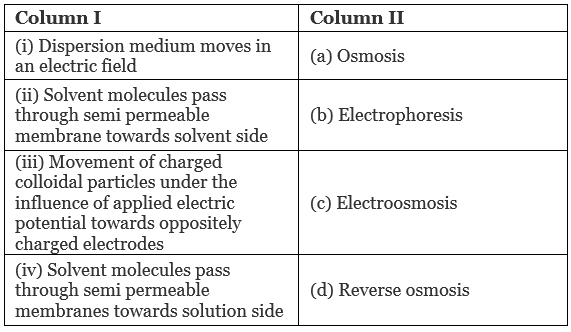
Ans. (i) → (c), (ii) → (d), (iii) → (b), (iv) → (a)
Solution.
(i) Dispersion medium moves in an electric field is known as electroosmosis.
(ii) Solvent molecules pass through semipermeable membrane towards solvent side is known as reverse-osmosis.
(iii) Movement of charged colloidal particles under the influence of applied electric potential towards oppositely charge electrodes is known as electrophoresis.
(iv) Solvent molecules pass through semipermeable membranes towards solution side is known as osmosis.
Q.69. Match the items given in Column I and Column II.
Ans. (i) → (b), (ii) → (c), (iii) → (d), (iv) → (a)
Solution.
(i) Lyophobic colloid (solvent hating colloid) are readily protected by small amount of electrolyte. These colloids are also stabilised by addition of lyophilic colloids which makes a protective layer around lyophobic sol. Hence, lyophilic sol are known as protective colloid.
(ii) Liquid-liquid colloid is also known as emulsion if they are partially miscible or immiscible liquids.
(iii) When FeCI3 is added to hot water it lead to the formation of positively charged colloid.
(iv) When NaOH is added to FeCI3 it lead to the formation of negatively charged colloid.
Q.70. Match the types of colloidal systems given in Column I with the name given in Column II.
Ans. (i) → (b), (ii) → (c), (iii) → (d), (iv) → (a)
Solution.
Colloids are classified on the basis of types of dispersed phase and dispersion medium
Q.71. Match the items of Column I and Column II.
Ans. (i) → (d), (ii) → (c), (iii) → (a), (iv) → (b)
Solution.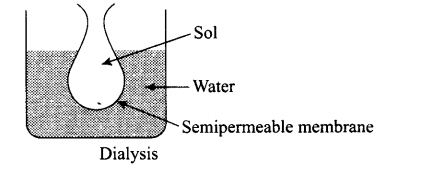
(i) Purification of colloid can be done by dialysis in which ions/particles are removed from solution through semipermeable membrane.
(ii) Peptisation may be defined as the process of converting a precipitate into colloidal sol by shaking it with dispersion medium in the presence of small amount of electrolyte.
(iii) The process of removal of oily or greasy dirt from the cloth is done by emulsification.
(iv) The movement of colloidal particles under an applied electric potential is called electrophoresis.
Q.72. Match the items of Column I and Column II.
Ans. (i) → (d), (ii) → (c), (iii) → (a), (iv) → (b)
Solution.
(i) Butter is an example of dispersion of liquid in solid.
(ii) Pumice stone is an example of dispersion of gas in solid in which gas bubbles are pearled within solid particles.
(iii) Milk is a dispersion of liquid In liquid in which fats and protein are dissolved in milk.
(iv) Paint is an example of solid in liquid.
Assertion and Reason Type
Note: In the following questions a statement of assertion followed by a statement of reason is given. Choose the correct answer out of the following choices.
(i) Assertion and reason both are correct and the reason is correct explanation of assertion.
(ii) Assertion and reason both are correct but reason does not explain assertion.
(iii) Assertion is correct but reason is incorrect.
(iv) Both assertion and reason are incorrect.
(v) Assertion is incorrect but reason is correct.
Q.73. Assertion: An ordinary filter paper impregnated with collodion solution stops the flow of colloidal particles.
Reason: Pore size of the filter paper becomes more than the size of colloidal particle.
(i) Assertion and reason both are correct and the reason is correct explanation of assertion.
(ii) Assertion and reason both are correct but reason does not explain assertion.
(iii) Assertion is correct but reason is incorrect.
(iv) Both assertion and reason are incorrect.
(v) Assertion is incorrect but reason is correct.
Ans. (iii)
Solution.
An ordinary filter paper impregnated with collodion solution stops the flow of colloidal particles because pore size of the filter paper becomes smaller than the size of colloidal particles.
Q.74. Assertion: Colloidal solutions show colligative properties.
Reason: Colloidal particles are large in size.
(i) Assertion and reason both are correct and the reason is correct explanation of assertion.
(ii) Assertion and reason both are correct but reason does not explain assertion.
(iii) Assertion is correct but reason is incorrect.
(iv) Both assertion and reason are incorrect.
(v) Assertion is incorrect but reason is correct.
Ans. (ii)
Solution.
- Colloidal particles being bigger aggregates, the number of particles in a colloidal solution is comparatively small as compared to a true solution.
- Hence, the values of colligative properties (osmotic pressure, lowering in vapour pressure, depression in freezingpoint and elevation in boiling point) are of small order as compared to values shown by true solutions at same concentration.
Q.75. Assertion: Colloidal solutions do not show brownian motion.
Reason: Brownian motion is responsible for stability of sols.
(i) Assertion and reason both are correct and the reason is correct explanation of assertion.
(ii) Assertion and reason both are correct but reason does not explain assertion.
(iii) Assertion is correct but reason is incorrect.
(iv) Both assertion and reason are incorrect.
(v) Assertion is incorrect but reason is correct.
Ans. (v)
Solution.
Colloidal solutions show Brownian motion and this Brownian motion is responsible for stability of sols.
Q.76. Assertion: Coagulation power of Al3+ is more than Na+.
Reason: Greater the valency of the flocculating ion added, greater is its power to cause precipitation (Hardy Schulze rule).
(i) Assertion and reason both are correct and the reason is correct explanation of assertion.
(ii) Assertion and reason both are correct but reason does not explain assertion.
(iii) Assertion is correct but reason is incorrect.
(iv) Both assertion and reason are incorrect.
(v) Assertion is incorrect but reason is correct.
Ans. (i)
Solution.
According to Hardy-Schulze law greater the charge/valency on flocculating ion added greater will be its power to cause precipitation.
Coagulating power ∝ Valency of flocculating ion
Q.77. Assertion: Detergents with low CMC are more economical to use.
Reason: Cleansing action of detergents involves the formation of micelles. These are formed when the concentration of detergents becomes equal to CMC.
(i) Assertion and reason both are correct and the reason is correct explanation of assertion.
(ii) Assertion and reason both are correct but reason does not explain assertion.
(iii) Assertion is correct but reason is incorrect.
(iv) Both assertion and reason are incorrect.
(v) Assertion is incorrect but reason is correct.
Ans. (i)
Solution.
Detergents with low CMC are more economical to use as they involves the formation of micelle which is used for cleaning of oil and dirt from our cloth. Micelle formation takes place when the concentration of detergent becomes equal to CMC.
LONG ANSWER TYPE QUESTIONS
Q.78. What is the role of adsorption in heterogenous catalysis?
Ans. Catalyst is used to increase rate of reaction. Heterogeneous catalyst is used to increase rate of reaction in which catalyst is not in phase with reactants and products.
Role of adsorption in heterogeneous catalysis are:
- Diffusion of reactants to the surface of the catalyst.
- Reactants are adsorbed on the catalyst surface.
- Occurrence of chemical reaction at catalyst surface.
- Desorption.
- Diffusion of reaction products away from the catalysts surface.
Example
Q.79. What are the applications of adsorption in chemical analysis?
Ans. There are various applications of adsorption in chemical analysis.
Some of which are as follows:
(i) In thin layer chromatography: The lower adsorbing particles come out readily while another having higher adsorbing tendency comes out later. On this basis compounds are separated or analysed.
(ii) In adsorption indicators: Surface of certain precipitate has an ability to adsorb some dyes to produce a characteristic colour e.g., AgX adsorbs eosin dye and thereby producing a characteristic colour at the end point.
(iii) In qualitative analysis: Specific material has specific adsorption tendency so particular ion can be identified very easily.
(iv) In the separation of inert gases: Different inert gases are adsorbed to different extents at different temperatures on coconut charcoal. This forms the basis of their separation from a mixture.
Q.80. What is the role of adsorption in froth floatation process used especially for concentration of sulphide ores?
Ans. In froth floatation process sulphide ore is shaken with pine oil and water, the ore particles are adsorbed on froth that floats and the gangue particles settle down in tank. Thus, role of adsorption in froth floatation process can be understood as following processes:
- Adsorption of pine oil on sulphide ore particles.
- Formation of emulsion takes place.
- Froth is formed along with ore particles.
- Mechanism of the functioning of shape selective catalysis.
- As sulphides are extracted using froth floatation method therefore, only sulphide ore particles will show this type of adsorbing tendency.
Q.81. What do you understand by shape selective catalysis? Why are zeolites good shape selective catalysts?
Ans. The catalytic reaction which depends upon pore structure of catalyst and the size of the reactant and product molecules is known as shape selective catalysts. Zeolites are good shape selective catalyst because of honey comb like structure.
(i) They are microporous aluminosilicates with Al–O–Si framework and general formula Mx/n [(AIO2) x (SiO2)y] mH2O
(ii) The reactions taking place in zeolites depend upon the size and shape of the reactant and product molecules as well as upon the pores and cavities of the zeolites.
(iii) Zeolites are widely used as catalysts in petrochemical industries for cracking of hydrocarbonds and isomerisation. They are also used for removing permanent hardness of water.
(iv) e.g., ZSM-5 is a catalyst used in petroleum industry
Alcohols  Gasoline(petrol) (A mixture of hydrocarbons)
Gasoline(petrol) (A mixture of hydrocarbons)
|
334 videos|651 docs|300 tests
|
FAQs on NCERT Exemplar: Surface Chemistry (Old NCERT) - Chemistry for JEE Main & Advanced
| 1. What is surface chemistry? |  |
| 2. How is surface chemistry important in everyday life? |  |
| 3. What is adsorption? |  |
| 4. How does surface area affect the rate of a chemical reaction? |  |
| 5. What are catalysts and how do they work in surface chemistry? |  |
















